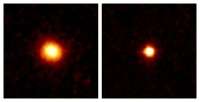New class of old star cluster discovered

(Phys.org) —Star clusters with properties not seen before have been discovered by an international team of astrophysicists, led by Swinburne University of Technology's Professor Duncan Forbes.
Using data from the Hubble Space Telescope and the W M Keck Observatory's 10 metre telescope in Hawaii, the researchers found several star clusters with sizes and masses that were previously not known to exist.
"Old, compact star clusters, such as globular clusters, are well known to amateur astronomers," Professor Forbes said.
"Although globular star clusters were first discovered in 1665, it has taken more than 340 years to fully appreciate all the different types of star clusters that are made in the Universe."
The researchers confirmed the existence of a number of different star clusters, overturning the idea that star clusters only come in certain types.
"We now know that star clusters have a rather continuous range of size and mass without any gaps in their properties," Professor Forbes said.
"Our discovery was made possible by using the Hubble Space Telescope to measure the sizes of the star clusters and long exposures on the DEIMOS instrument fitted to the Keck II telescope to obtain distances and confirm their status." Professor Jean Brodie, a team member from the University of California, said.
They also measured the colour of the star clusters, finding the lower mass ones to be red and the higher mass ones to be blue in colour, suggesting differences in their chemical composition.
"No single model for the formation of these star clusters can currently reproduce the diversity of structural properties we have observed for old star clusters," Professor Forbes said.
"Our observations present a challenge to researchers aiming to reproduce star clusters in computer simulations."
The research team included Vincenzo Pota and Christopher Usher (Swinburne University of Technology), Jay Strader (Michigan State University), Aaron Romanowsky (San Jose State University), Jean Brodie and Jacob Arnold (University of California), and Lee Spitler (Macquarie University).
The paper has been accepted for publication in the Monthly Notices of the Royal Astronomical Society, published by Oxford University Press.
The Deep Extragalactic Imaging Multi-Object Spectrograph (DEIMOS) is capable of gathering spectra from 130 galaxies or more in a single exposure. In "Mega Mask" mode, DEIMOS can take spectra of more than 1,200 objects at once, using a special narrow-band filter.
Journal information: Monthly Notices of the Royal Astronomical Society
Provided by Swinburne University of Technology
















